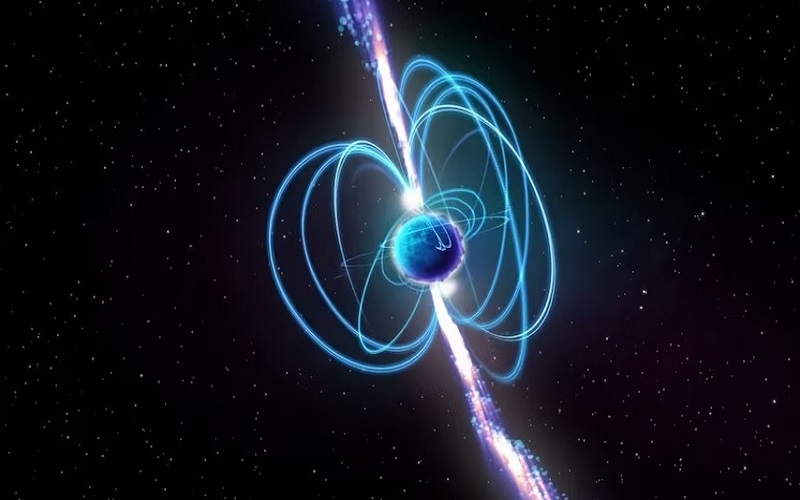An international team has found an unusual type of star with characteristics that are beyond our comprehension and that they believe may be an ultra-long-period magar, a rare type of star with very strong magnetic fields.
The research, made public on Wednesday in Nature, was made by a global group of scientists, which includes scientists of the Institute of Space Sciences (ICE-CSIC) and is led by astronomers from the University of Curtin (Australia) of the International Center for Radioastronomic Research (ICRAR).
Researchers believe that the object is an ultra-long-period magar, which is a rare type of star that has extremely strong magnetic fields that could produce powerful explosions of energy, or a magnetic white dwarf, which is a stage of advanced development in the development of a sun-like star, but neither can explain 100% of the features of the new star.
The previous magnetars rotated for just a few seconds; however, the new one emits radio waves every 21 minutes and is the longest-running radiomagnetar ever discovered.
Radio Telescope Network
Astronomers spotted the object by using the Murchison Widefield Array (MWA) radiotelescope found within the Aboriginal Wajarri Yamaji Country, located in the interior region of Western Australia.
The magnetar, named GPM J1839-10, is 15,000 light-years away from Earth and located within the constellation of Scutum.
“This remarkable object is a challenge to our understanding of magnetars and neutron stars, which are among the most mysterious and exotic objects of the Universe,” said lead author Natasha Hulley-Walker.
The star is the second of this kind discovered so far, following its discovery by a 2021 student at Curtin University. The object (also described in Nature in 2022) was a radio source that re-emitted its frequency every 18 minutes. The source shined for three months and then vanished.
“We were confused and began searching for similar objects in order to figure out if this was a single incident or just the tip of the glacier,” Hurley explained.
To accomplish this, in the summer of 2022, the team was able to scan the Milky Way using the MWA telescope and then give, using GPM J1839-10, a signal that repeated every 21 minutes. It was derived from a different region of the sky, which was more than 15,000 light years away from the sky, towards the constellation of Scutum.
An international network of radio telescopes
To better understand the object, researchers utilized telescopes from all over the world to follow the object and study its characteristics using various frequencies and recording signals with high resolution.
In addition, they employed three CSIRO radiotelescopes from Australia, the MeerKAT Radiotelescope from South Africa, the XMM-Newton Space Telescope, and the Grantecan (GTC) telescope located on the island of La Palma, in the Canary Islands.
What they discovered in GPM J1839-10 was unique: the discovery of a source with an extremely strong magnetic field that is rotating, producing pulses lasting as long as 5 minutes.
But that’s not what was most exciting. By using the celestial coordinates as well as the features of GPMJ1839-10, the team analyzed the observation files of the top radiotelescopes in the world and found that the object has been in operation for at most 33 years.
“Our object was recorded in the archives of India’s Giant Metric Wave Radiotelescope (GMRT) as well as the U.S. Very Large Array (VLA), which had observations that date back to 1988.” Hurley explained.
A mystery to unravel
Based on data collected over the past thirty years, scientists have determined that the source is not slowing down, and according to complex simulations carried out by CSIC scientists at ICE, theories are not able to explain how a glowing radio emission could be sustained for this long.
“Assuming it is magnetar, it would not be possible for the object to generate radio waves. However, we’re experiencing them. And we’re not talking about a tiny flash of radio emission. Every 22 minutes, it releases five minutes of radiowave energy, and it has been doing this for a minimum of 33 years. Whatever mechanism is responsible for this phenomenon, it’s truly remarkable.”
The findings have important implications for understanding the nature of neutron stars and the behavior of magnetic fields in extreme conditions. It also raises questions about the origin and evolution of magnetic fields and about the origins of mysterious phenomena like rapid radio rays.
As long as the source continues to be active, astronomers all over the globe will continue to research it in order to improve their understanding and find its secrets.

Email: ben@satprwire.com Phone: +44 20 4732 1985
Ben has been listening to the technology news for quite some time that he needs just a single read to get an idea surrounding the topic. Ben is our go-to choice for in-depth reviews as well as the normal articles we cover on a normal basis.



